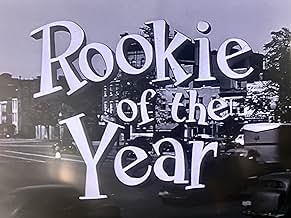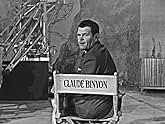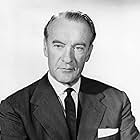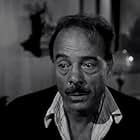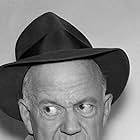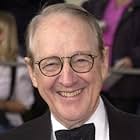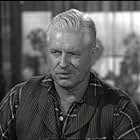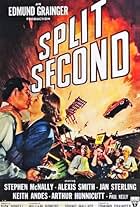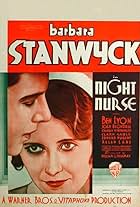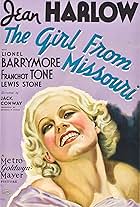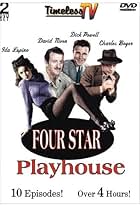Presented by Eastman Kodak, this show was a series of original scripts directed by acclaimed directors and featuring well-known performers. The stories ranged from musicals to comedies and d... Read allPresented by Eastman Kodak, this show was a series of original scripts directed by acclaimed directors and featuring well-known performers. The stories ranged from musicals to comedies and dramas.Presented by Eastman Kodak, this show was a series of original scripts directed by acclaimed directors and featuring well-known performers. The stories ranged from musicals to comedies and dramas.
- Awards
- 1 nomination
Browse episodes
Storyline
Did you know
- TriviaThe stories ranged from musicals to comedies and dramas.
- Alternate versionsSome episodes were rerun in 1958 under the title "Personal Appearance" (1958).
Featured review
"Screen Directors Playhouse", produced by (and filmed at) the Hal Roach Studio, was one of the very best of the 1950s anthology TV series. It featured an "A"-list of the best directors and actors working in films at that time.
SPOILERS COMING. The best episode is probably "Rookie of the Year" (7 Dec '55), starring John Wayne and directed by John Ford: both making their TV debuts. Wayne plays an unemployed sportswriter who scouts a talented baseball pitcher (played by his own son, Patrick Wayne). The sportswriter discovers a secret in the pitcher's past: a "scoop" which the sportswriter can parlay into a job for himself at any sports desk in the country ... but only by ruining the pitcher's career. The script is marred by some hokey gimmicks designed to generate false suspense. Just before the commercial break, a woman we've never seen before (Vera Miles) runs in and points a revolver at John Wayne's head. This is meant to keep us glued to our seats until after the commercial ... when Wayne calmly takes the gun away and asks her what this is all about. The ending is implausible, with James Gleason as a hardboiled newspaper editor who passes up a good story for the sake of sentiment. (Not likely!)
Another excellent episode is "High Air" (12 Sept '56), directed by Frank Borzage, starring William Bendix and a young Dennis Hopper as father-and-son sandhogs. Bendix and Hopper don't look like father and son until they face off in profile ... and then we suddenly notice they've got identical noses! Based on a 1934 short story by Borden Chase, "High Air" is about an estranged father and son who work on the same crew digging a tunnel under the East River, constantly risking the hideous crippling condition known as "the bends". (Obscure actor Hal Baylor gives an astonishing performance as a caisson labourer in the throes of this agonising condition.) When a "blow" punctures a hole in the tunnel wall, Bendix plugs it with his own body to give Hopper a chance to escape. In the original story, Bendix's character died: here, he implausibly survives ... with "the worst case of bends I've ever seen". Having seen how bad the bends can be, I'd rather die.
The best-known episode (because it's available on video) is "The Silent Partner" (21 Dec '55), directed by comedy veteran George Marshall, starring Buster Keaton, Joe E. Brown, ZaSu Pitts and Jack Elam. I'm a Keaton fan, but this isn't one of his finest hours: "The Silent Partner" plays out the old cliché of the incompetent dimwit who becomes a star comedian through his own ineptitude. In real life, Keaton and Joe E. Brown had parallel lives: both suffered downturns due to alcoholism, both men were athletes who played baseball whenever possible, and both men got tricked into marrying the same woman! Here, Brown plays a showman who gets successful at Keaton's expense, then makes up for it when Keaton is a forgotten failure. The story is a bit too close to Keaton's real life to be funny. At the beginning of this episode, we see a staged scene of Marshall discussing the script with an actor in costume as a Keystone Cop ... but we never see this actor (or anyone dressed like him) in the story itself. "The Silent Partner" is one of the lesser episodes of this series, but the entire run of "Screen Directors Playhouse" had such high quality (and featured so many big names) that even a clinker is worth viewing.
Overall, I'll rate this series 8 out of 10.
SPOILERS COMING. The best episode is probably "Rookie of the Year" (7 Dec '55), starring John Wayne and directed by John Ford: both making their TV debuts. Wayne plays an unemployed sportswriter who scouts a talented baseball pitcher (played by his own son, Patrick Wayne). The sportswriter discovers a secret in the pitcher's past: a "scoop" which the sportswriter can parlay into a job for himself at any sports desk in the country ... but only by ruining the pitcher's career. The script is marred by some hokey gimmicks designed to generate false suspense. Just before the commercial break, a woman we've never seen before (Vera Miles) runs in and points a revolver at John Wayne's head. This is meant to keep us glued to our seats until after the commercial ... when Wayne calmly takes the gun away and asks her what this is all about. The ending is implausible, with James Gleason as a hardboiled newspaper editor who passes up a good story for the sake of sentiment. (Not likely!)
Another excellent episode is "High Air" (12 Sept '56), directed by Frank Borzage, starring William Bendix and a young Dennis Hopper as father-and-son sandhogs. Bendix and Hopper don't look like father and son until they face off in profile ... and then we suddenly notice they've got identical noses! Based on a 1934 short story by Borden Chase, "High Air" is about an estranged father and son who work on the same crew digging a tunnel under the East River, constantly risking the hideous crippling condition known as "the bends". (Obscure actor Hal Baylor gives an astonishing performance as a caisson labourer in the throes of this agonising condition.) When a "blow" punctures a hole in the tunnel wall, Bendix plugs it with his own body to give Hopper a chance to escape. In the original story, Bendix's character died: here, he implausibly survives ... with "the worst case of bends I've ever seen". Having seen how bad the bends can be, I'd rather die.
The best-known episode (because it's available on video) is "The Silent Partner" (21 Dec '55), directed by comedy veteran George Marshall, starring Buster Keaton, Joe E. Brown, ZaSu Pitts and Jack Elam. I'm a Keaton fan, but this isn't one of his finest hours: "The Silent Partner" plays out the old cliché of the incompetent dimwit who becomes a star comedian through his own ineptitude. In real life, Keaton and Joe E. Brown had parallel lives: both suffered downturns due to alcoholism, both men were athletes who played baseball whenever possible, and both men got tricked into marrying the same woman! Here, Brown plays a showman who gets successful at Keaton's expense, then makes up for it when Keaton is a forgotten failure. The story is a bit too close to Keaton's real life to be funny. At the beginning of this episode, we see a staged scene of Marshall discussing the script with an actor in costume as a Keystone Cop ... but we never see this actor (or anyone dressed like him) in the story itself. "The Silent Partner" is one of the lesser episodes of this series, but the entire run of "Screen Directors Playhouse" had such high quality (and featured so many big names) that even a clinker is worth viewing.
Overall, I'll rate this series 8 out of 10.
- F Gwynplaine MacIntyre
- Sep 25, 2002
- Permalink
Details
- Runtime30 minutes
- Color
- Aspect ratio
- 1.33 : 1
Contribute to this page
Suggest an edit or add missing content

Top Gap
By what name was Screen Directors Playhouse (1955) officially released in India in English?
Answer





